I sat in my hotel room on a Sunday morning, alone, feeling rather anxious. I looked at the clock. It was 7.22am. I was being picked up sometime between 7.30 and 8.00am. I checked my packing list yet again, as if hoping it would provide some comfort. I got up from the chair and sat on the edge of the bed, noting it would be the last time I’d see a real bed for a week. I checked the time again, 7.28am.
Two months prior I had booked a 6-day hike in the remote Tarkine rainforest, on the wild west coast of Tasmania. I was keen to do more hiking, but as I sat waiting for the tour bus to pick me up, I was regretting launching into this hike as the first multi-day hike I had done in years. I booked a guided hike with Tarkine Trails, a subsidiary of Trek Tours Australia, a great company with an excellent reputation for guided hiking across Australia. I had very few clear memories of the last hike I had done in Tasmania, the famous Overland Track. I remembered aspects of it, but I didn’t have a clear memory of whether it was very hard or not. I recall coming home with bruises on my hips from the pack. Maybe it was harrowing and I’d forgotten.
It wasn’t so much the walking itself that was filling me with trepidation, as the potential for bodily injuries and 6 sleepless nights. I am a fussy sleeper at the best of times and 5 nights in a tent on a hiking air bed was not going to be an ideal sleeping arrangement. I had hoped to do a lot of training in the lead up, but the floods and rain had made it difficult to get to my planned walking tracks in the Blue Mountains. I did a few hikes and walked the local streets a few times with my pack. It was the first walk I did with my pack, weighing in at 16kg, that was the start of my anxiety. Up until then, I felt confident that I was fit enough to manage the hike, graded as ‘challenging’ (but not ‘epic’). But after doing my first pack walk, I was experiencing a strong pain in my right hip and my feet were covered in blisters. I only walked 12km on flat ground around the Nepean River. After the next practice pack walk, my hip was worse, my calves were cramping and my knees sore. I’m getting old, I thought. This is it; the demise of my body into multiple aches and pains. The panic started to swell inside as I reconsidered my ability to do a 6-day hike with close to 20kg on my back. I should have started with something shorter.
To compensate for my lack of hiking preparation, I started researching anything that could help. I found some specific stretches that helped the ache in my hip, and was regretting the recent lapse in my yoga practice. A fellow hiking friend suggested magnesium tablets, so I packed some of those too.
But now, I was here, ready or not, I had to suck it up and do it. There would be no going back once I left. The Tarkine is still largely unexplored as a walking region, making the track an incomparable experience of isolation and beauty in the wilderness. It also means there is no quitting part way through. Besides, being part of a group of 8 means you can’t let the rest of the group down. I was terrified of being the slowest, the least prepared person in the group.
I checked the clock again, 7.34am. I got up off the bed and stood helplessly in the middle of the hotel room. My gaze fell on my 15kg pack resting against a chair in the corner of the room. I stared at it for a moment, my brow furrowed, as if daring it to speak words of derision at me for embarking on such an adventure.
The bus arrived a few minutes later and I joined some of my fellow hikers.

The Art Hotel on York St in Launceston where I stayed before and after my hike
After picking everyone up we gathered at a trekking store for a pre-trip briefing and gear check. Here, I also had a tent, plate, cup, spork, 1 toilet paper roll and 6 days of food added to my pack. Now it was closer to 20kg. Oh geez. I ditched a few things I decided I wouldn’t need: the spare pair of thermal pants, my book, the third t-shirt. I was weighing up ditching my inflatable pillow of 79g. I kept it and I’d later be grateful for that decision when I eventually fashioned the optimal sleeping arrangement (a half inflated pillow on top of a bundled up jumper, all tied up in the hood of my sleeping bag to avoid slipping around).
We left Launceston and drove west for a few hours, stopping on the way for morning tea in Penguin, and arriving at the starting place of our hike in the early afternoon. It was about 20C and the sun was out. It was perfect hiking weather and remained that way for the whole trip. In what is usually a wet rainforest, it was quite a miracle to go without a single day of rain (or rather, the local drought was evidence of a changing climate). We walked for about an hour to the Arthur river and had wraps for lunch before making the first river crossing of the hike. I changed out of my hiking boots into my river shoes, rolled up my pants and stepped into the icy cold water. I was nervous, sliding on the rocky riverbed underfoot, gripping onto my hiking poles much more tightly than necessary, hoping I wouldn’t lose balance and topple over, pack and all into the river. Once I found my footing, I relaxed and enjoyed the experience, moving through nature rather than around her, and already looking forward to the next time we’d do another river crossing.
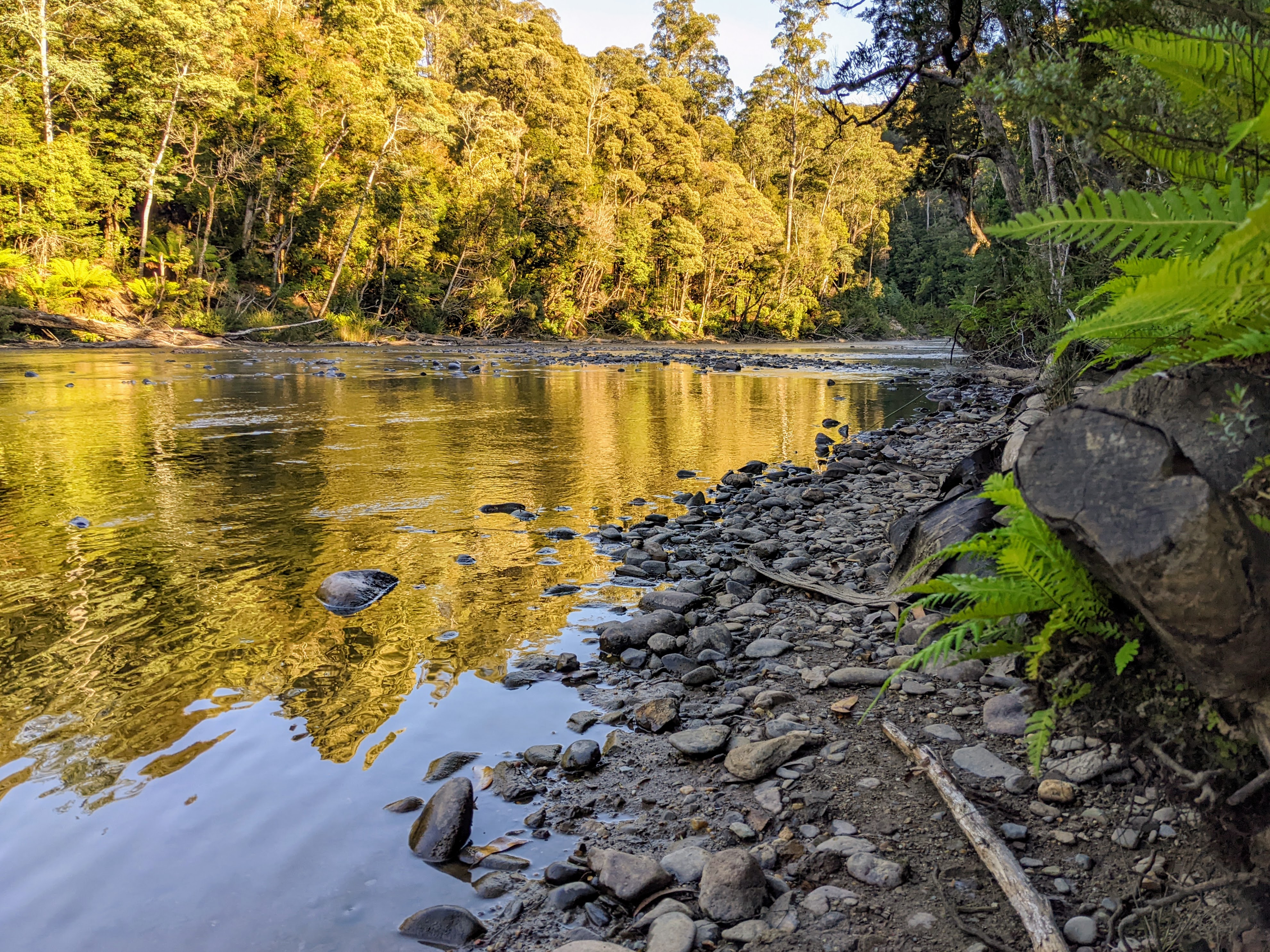
The Arthur River
After changing back into dry boots we set off for the steepest ascent we would do for the hike. It was uphill but we were on a fire trail so it was easy walking, one step in front of the other, pushing upwards. We walked on, entering the true rainforest, the canopy increasing in density, the blue sky becoming increasingly harder to see. A few hours on, we arrived at camp, quite late, darkness already approaching. The campsite was idyllic and the best ones were yet to come. We each found the flattest and clearest patch of forest floor we could to set up our little tents for the first time while our guides made dinner. We enjoyed a warming vegetable curry together, seated on stools made out of logs, under the forest canpoy, the star-spangled sky barely visible above.
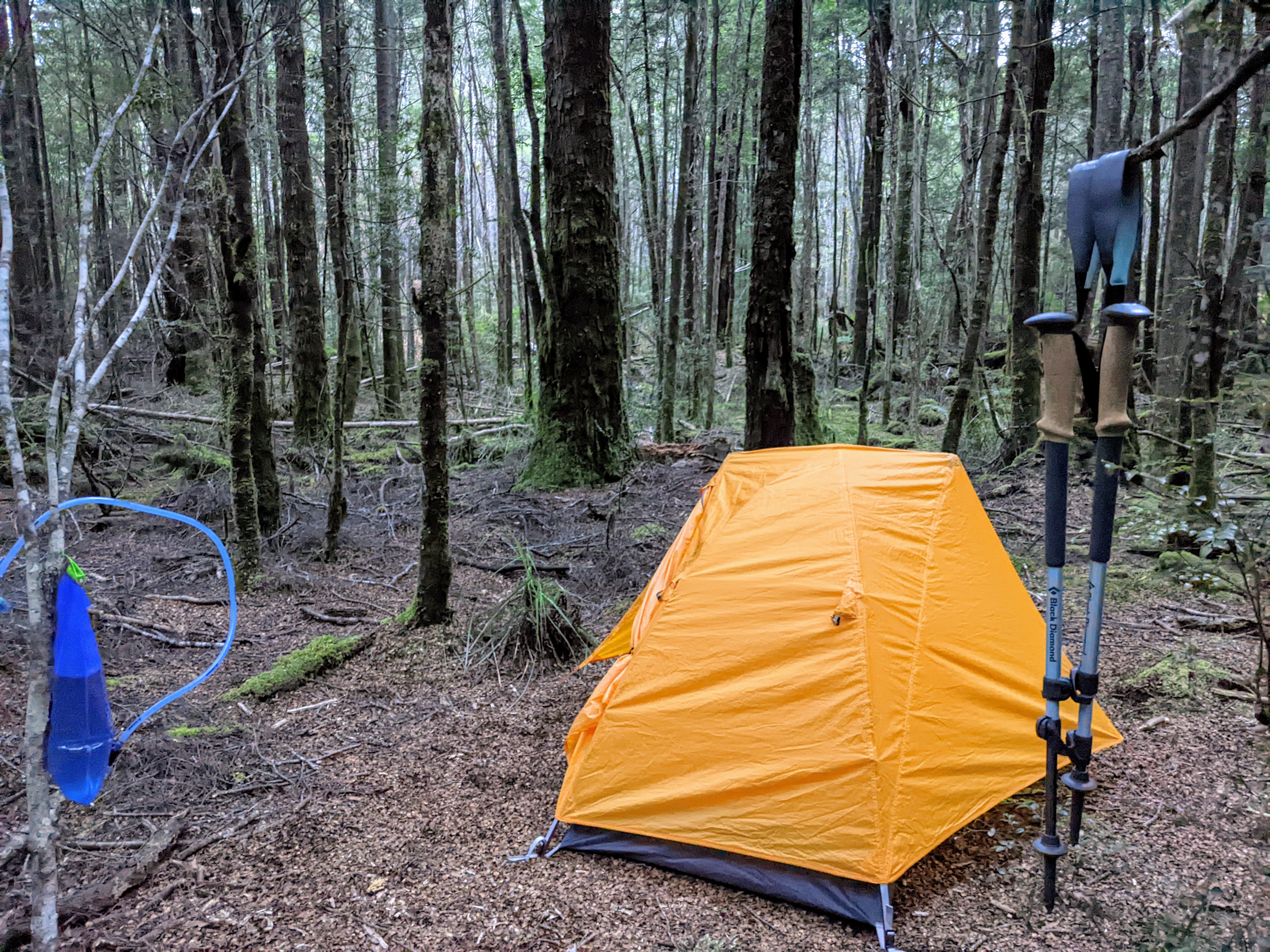
My camp set up for night one
I went to bed feeling relieved. My body was not aching and I had managed the hike easily enough, walking up the front and enjoying the company of my fellow hikers. I managed a few hours of sleep, sometimes adjusting my pillow, turning every now and then trying to find the most comfortable position.
On day 2 we rose early to pack up camp and start walking. We entered deeper into the forest and saw our first fungi. I never knew they came in such colours: bright orange, deep blues and purples, hot pink, fluro yellow, the whitest of whites and in all shapes and sizes. They grew from the leafy understory, from the sides of giant tree trunks, from the underside of fallen logs, sometimes in enormous clumps and sometimes as a tiny toadstool standing alone on the forest floor.
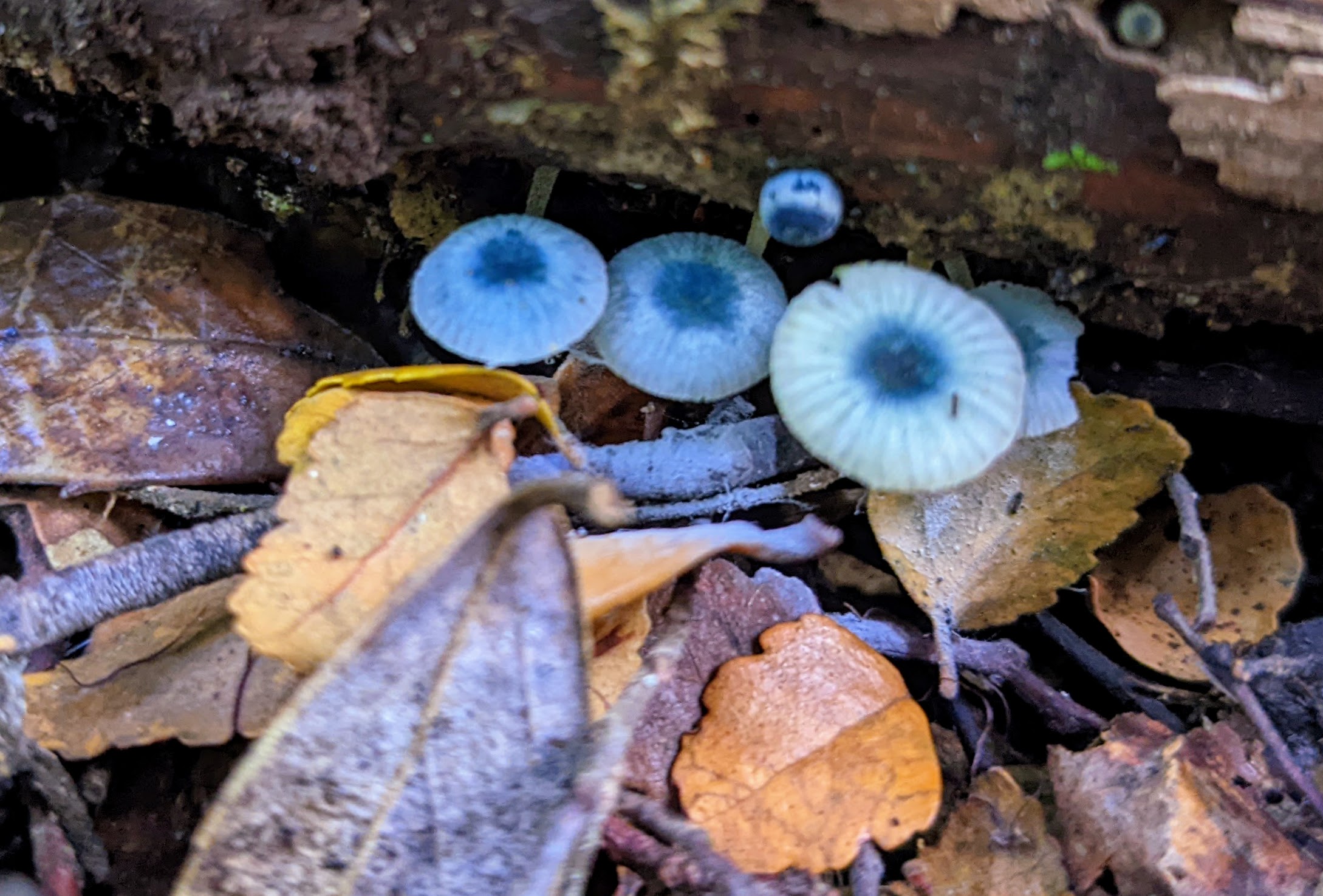
Beautiful blue fungi
The Tarkine is the largest cool temperate rainforest in the southern hemisphere. The duff was thick, the understory built up from centuries of decay. Some fallen trunks had lain dormant for so many years that they’d created a spongy forest floor, so soft it created a literal spring in your step as you bounced from moss-covered log to log. Some wood was so sodden and cushioned in moss that the fallen trunk created the perfect bed to lay on and rest during a lunch break.
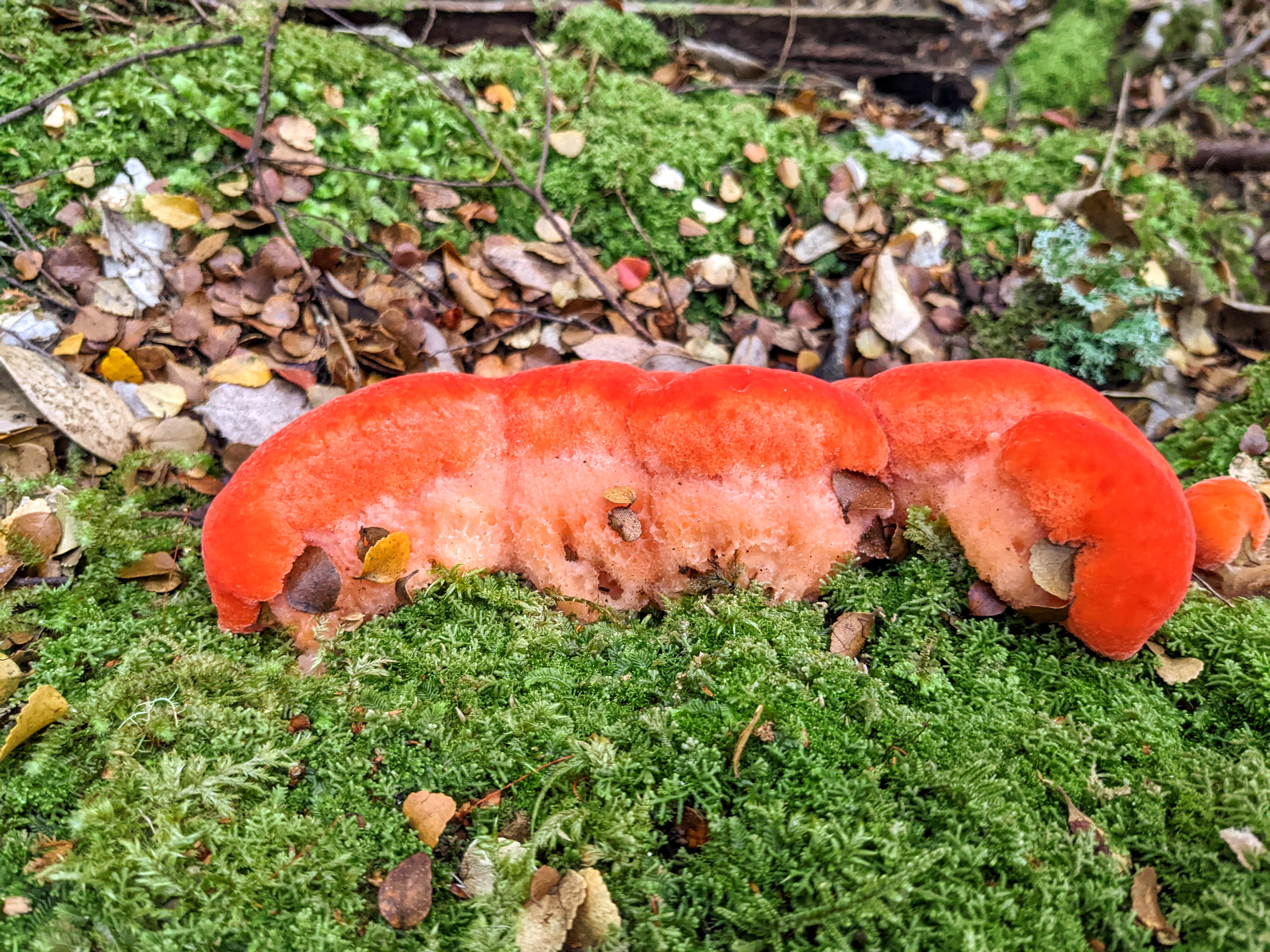
Bright orange fungi nestled in a bed of soft moss
We arrived at camp around 3pm that afternoon. I found a little clearing in the trees and set up my camp, a little faster than the first day. I put out my plastic mat and did some stretching in the dappled sunlight. The forest was less dense here and after dinner we found a clearing in the canopy large enough to do a little star gazing before bed.
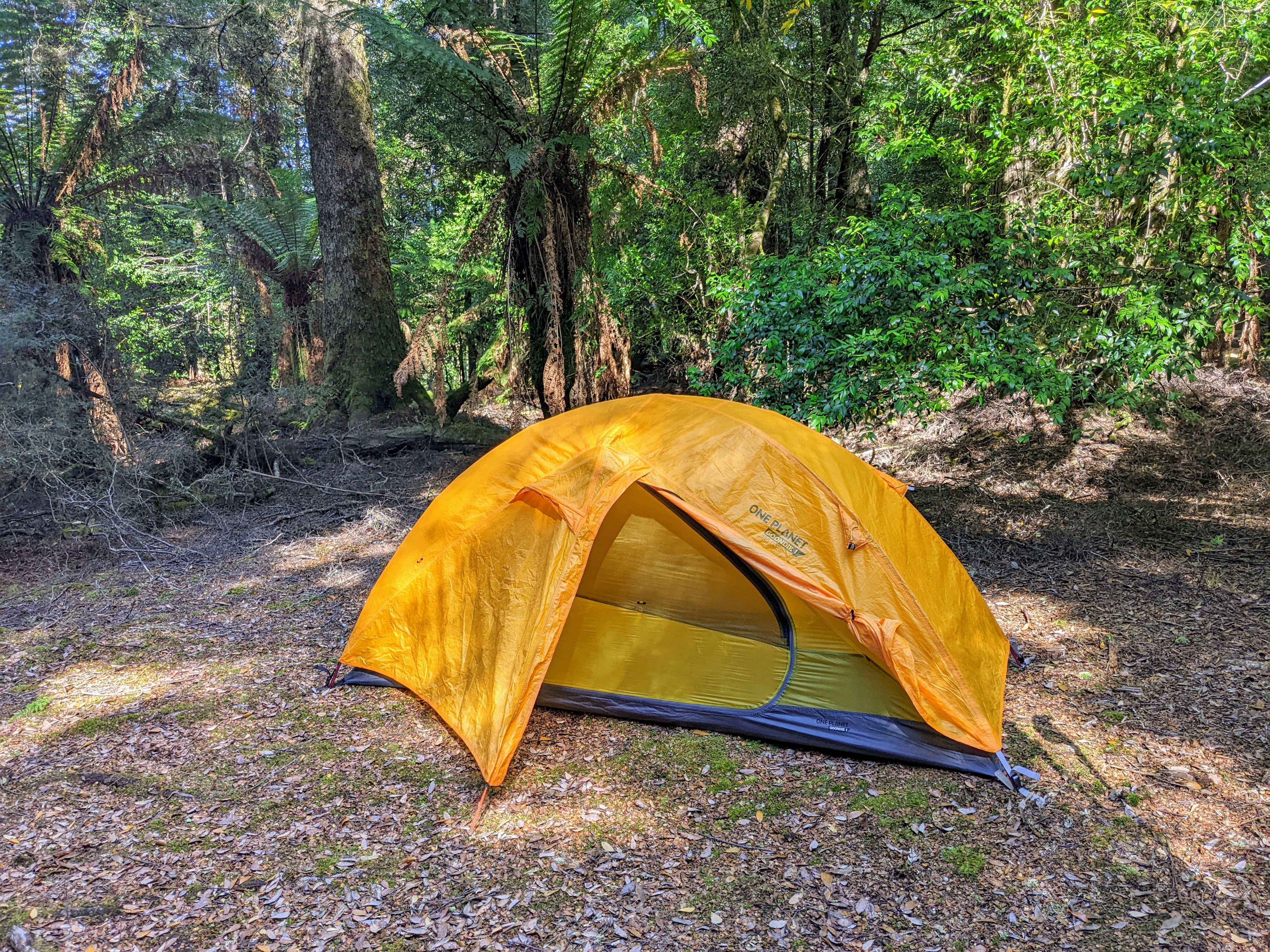
My camp set up for night two
On day 3, we packed up camp and set off, the morning routine of porridge, coffee and repacking our packs becoming increasingly familiar. We continued through the forest, up and down undulating hills and gullies of ancient ferns, stepping over fallen logs dripping with moss and sometimes walking around them when they were too big. At times, the undergrowth would be so soft from decomposed matter that it felt as though you may fall through to some hidden underworld. That day we had lunch under the largest myrtle beech tree in the forest, towering so far above it was almost impossible to see its crown.
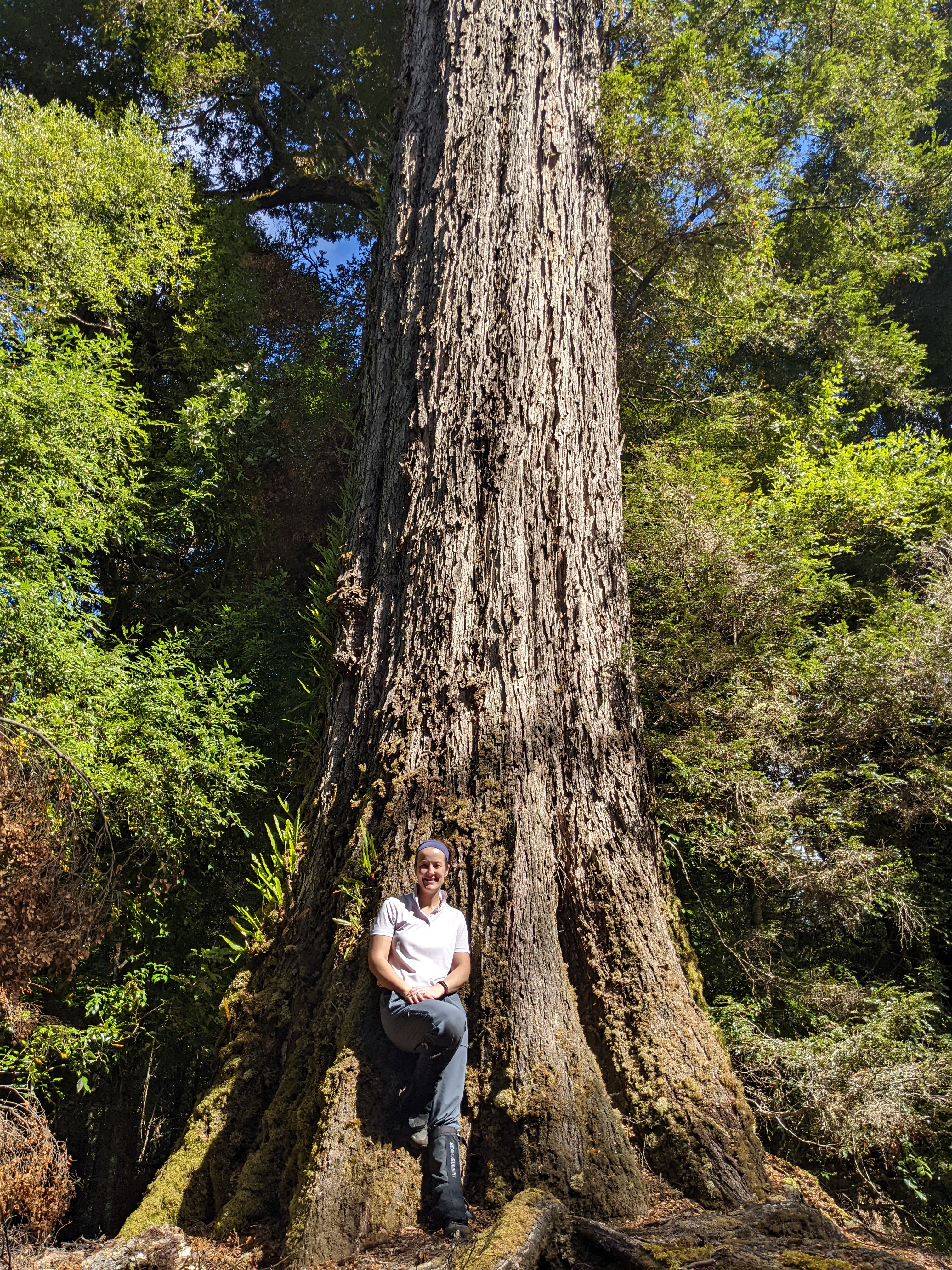
Standing under the giant myrtle beech tree
After lunch we had to traverse an area of forest filled with horizontal scrub, a slow growing tree endemic to the west of Tasmania. The plant is a member of an ancient Gondwanan plant family and it gets its name from the curious way it grows, sideways, forming virtually impenetrable thickets. The tree develops thick solid branches that droop under their own weight while still thin. They then thicken up and grow more vertical shoots, which in turn may droop as they thicken. The result is a tangled mess of branches. The lattice-work of tough, slippery branches was so thick you could barely see a walker only a few steps ahead. A few times, I had to remove my pack to get through the tangled mess of branches. It was slow moving but a lot of fun.
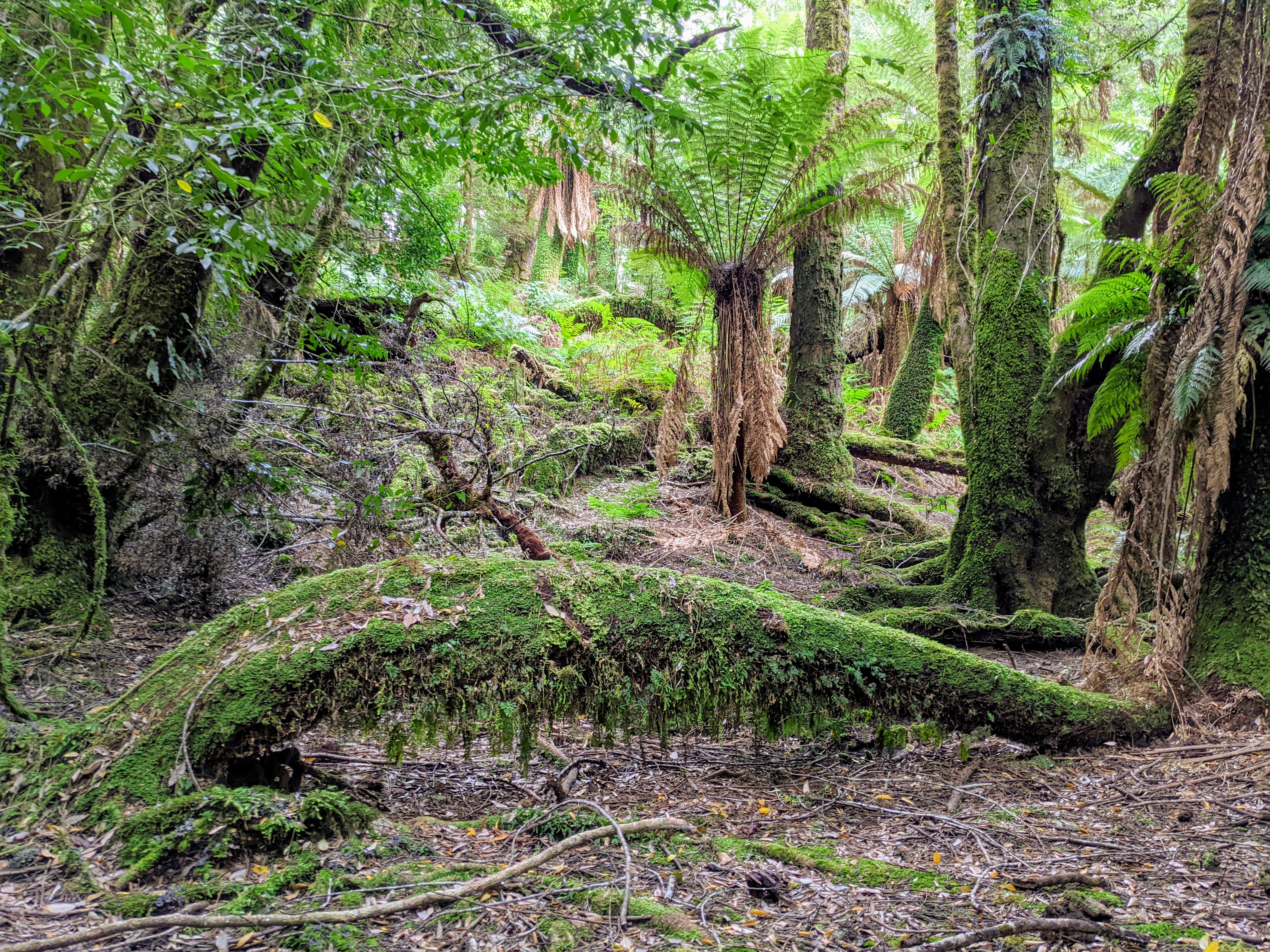
Logs dripping with moss
Later that afternoon we arrived at camp where we would stay for 2 nights. This was the most magical camp site you could imagine. Our tents were nestled in a fern-filled gully near a creek where we would later fall asleep to the sounds of a nearby waterfall plummeting into an icy pool. It was a warm afternoon when we arrived and I took the opportunity to stand under the waterfall to rinse myself while refilling my water bladder. I felt all my worries wash away with the sweat and dirt from 3 days of hiking.
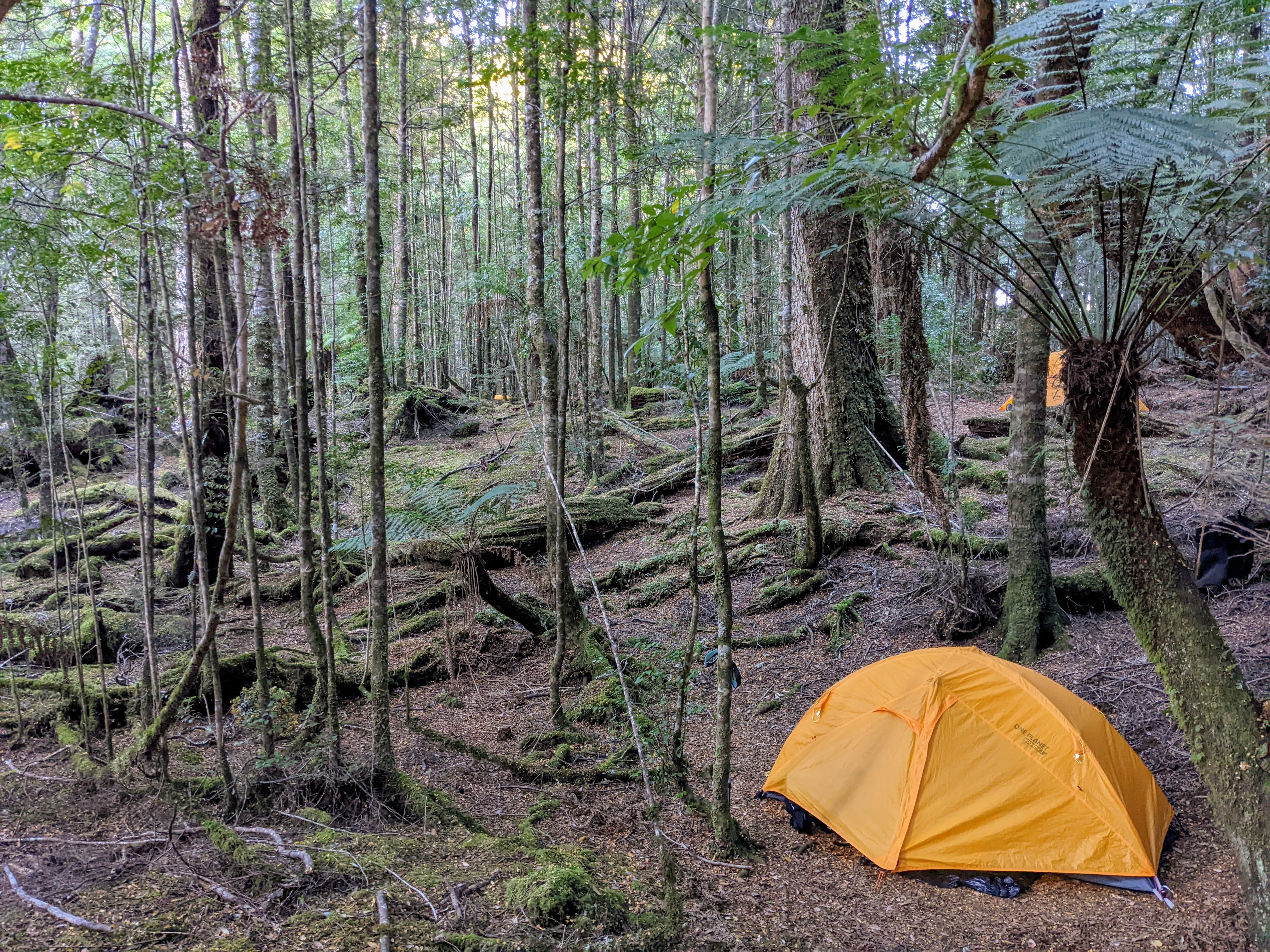
My camp set up for nights three and four
On day 4 we woke up a little later, not needing to pack up camp. I had slept through the entire night, cocooned in my sleeping bag, pillow adjustments perfected by now. This day we were to hike to the top of a hill, emerging from the rainforest and seeing open sky for the first time in 3 days. We carried a day pack and hiked to the lookout, feeling the wind whipping around us on the exposed hillside. As I stood there in the open space with 360 degree views all around me, I took a deep breath of fresh air, and felt an enormous sense of space filling me inside, inflating my very heart and spreading out into the expanse beyond. The feeling stayed with me during the descent and did not leave for hours, even as we re-entered the forest and the sky became obscured by the canopy once more.

A view from the lookout into the expanse beyond
After our lunch stop in the forest, the guides let us walk self-guided back to camp. I relished the few hours walking alone, and the challenge of navigating through the forest unguided, all senses on high alert, having to search for the pink trail markers rather than relying on following the person in front. For those few hours, there was not a person around and the only sounds were the crunching of leaf matter underfoot, my own deep breath and the occasional tweeting of a bird.
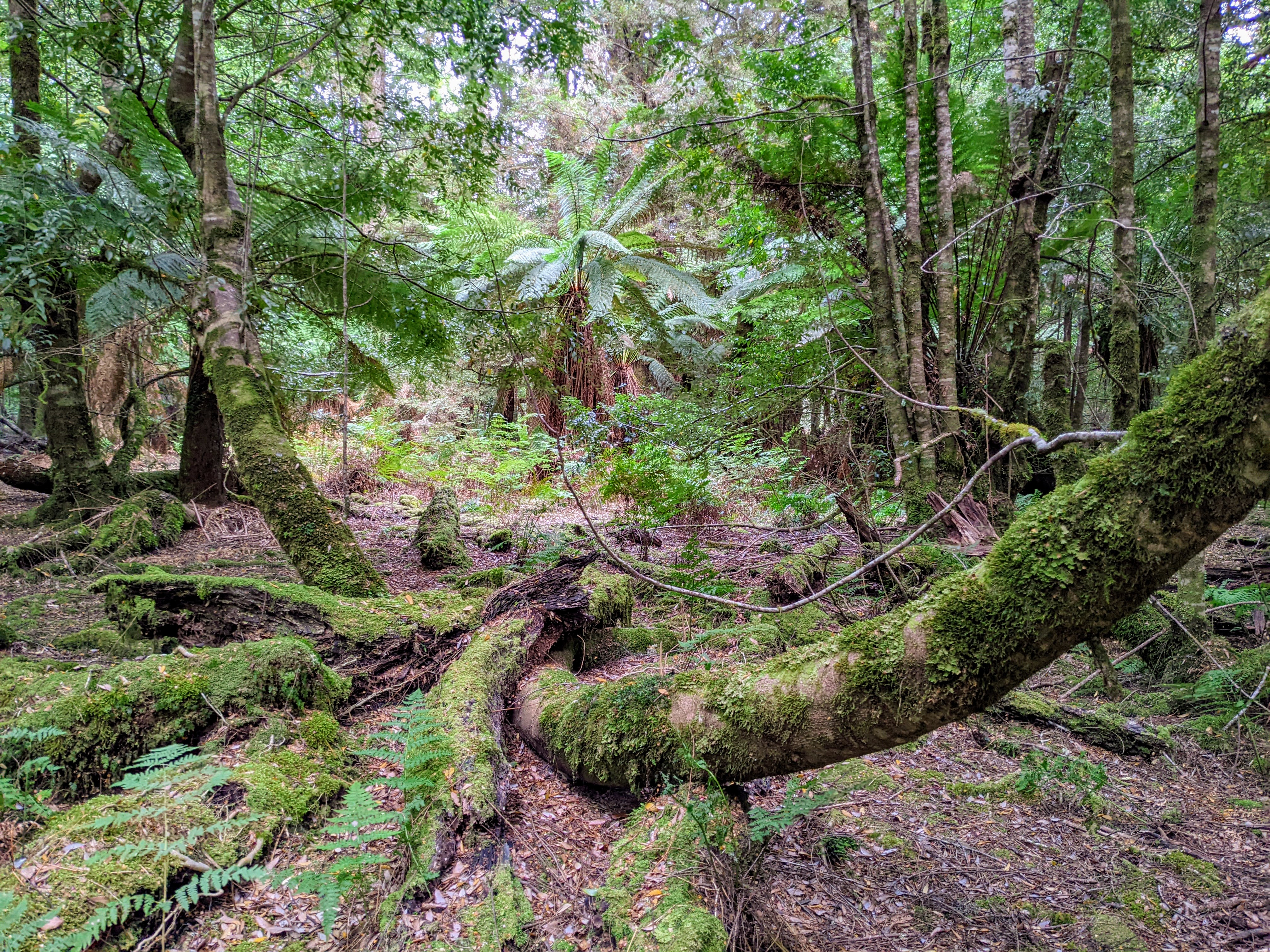
Wandering through the forest
By day 5, I was very efficient at packing up my camp, the routine second nature now. We left the rainforest and entered mixed forest, leaving the ferns behind and instead walking among the towering eucalypts. We ascended to a ridgeline where we stopped for morning tea in a clearing, taking a moment to bask in the warm sun pouring down on us. The weather could not have been more perfect.
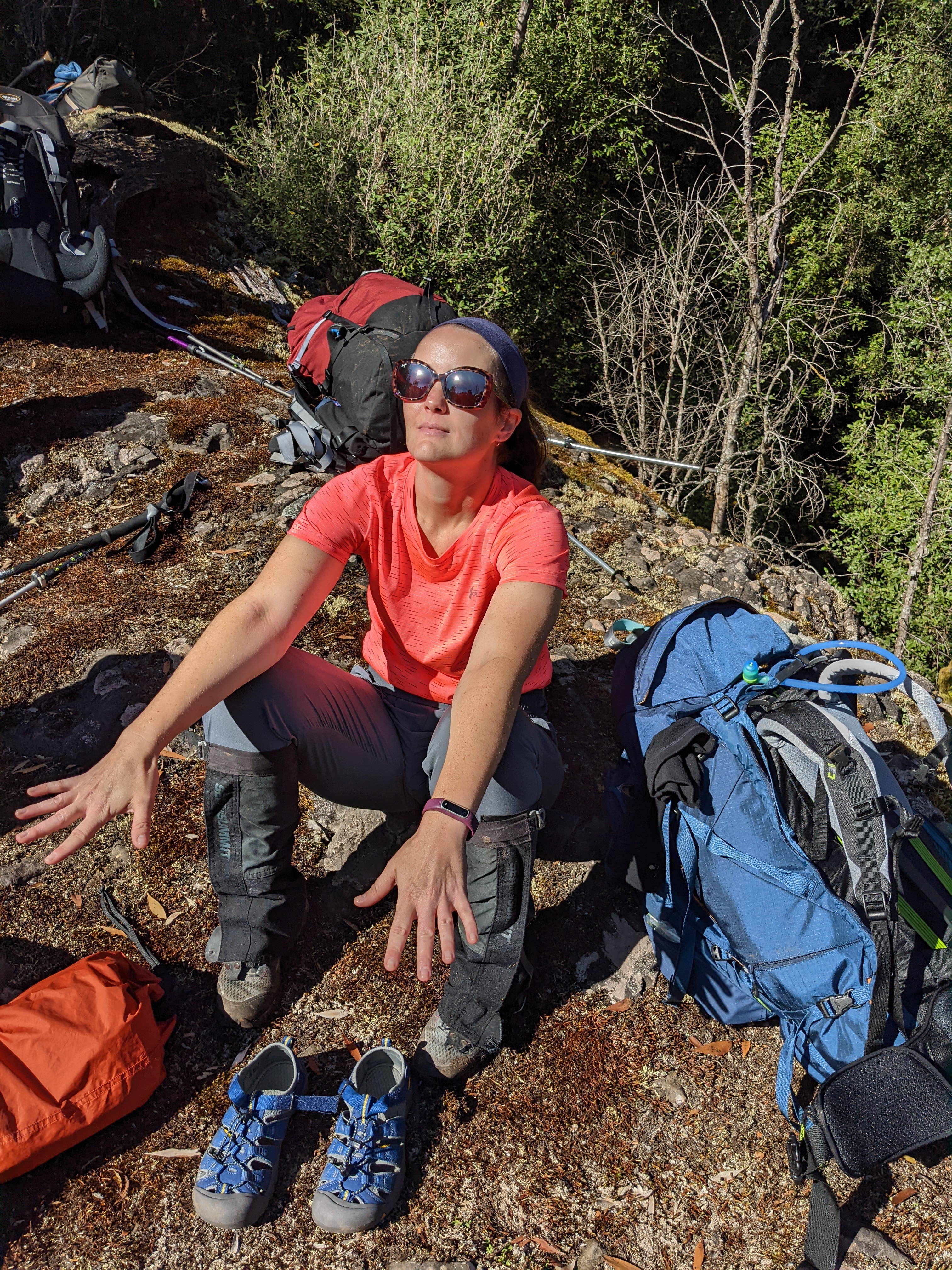
Enjoying a rare moment without the forest canpopy to bask in the sun
That afternoon we arrived at our final camp site, a very small area where finding a space for your tent was a matter of clearing the ground and finding a space with as few tree roots as possible. It was another beautiful place, located on the edge of a bubbling creek where we spent the afternoon playing and exploring, collecting pretty pebbles and dipping our feet in the creek. Once the sun went down, we could see the star-strewn sky above. I fell asleep easily that night, now used to my sleeping arrangement, feeling at home sleeping soundly in the forest, but feeling disappointed that I would wake to the last day of the hike.
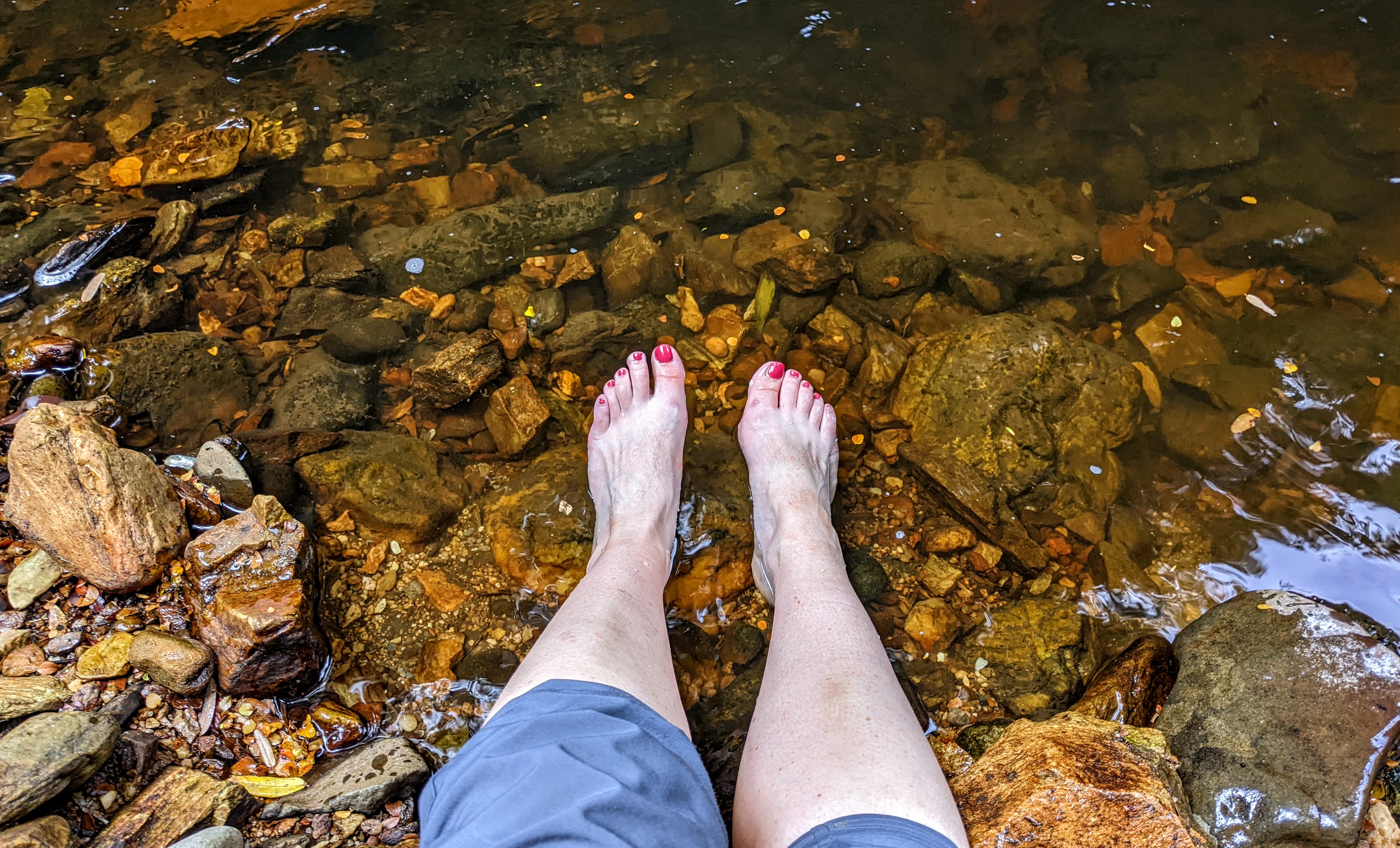
Cooling my feet in the creek at camp
On our last day we rose very early, eating our last porridge together and packing up in the dark. We crossed our creek, head torches lighting the way across to the other side. We started our final ascent, the sun rising with us as we made our way out of the forest. The sky lightened, our jumpers came off and we made our way to our final river crossing. Half way across, I paused, looking upstream and downstream, taking in nature in all her beauty: the early morning sun reflected off the water as a light cloud of mist danced across the still surface. On the other side, with a final burst of energy, we walked briskly to the end of our trail, packs feeling especially light now that they were empty of all our food.
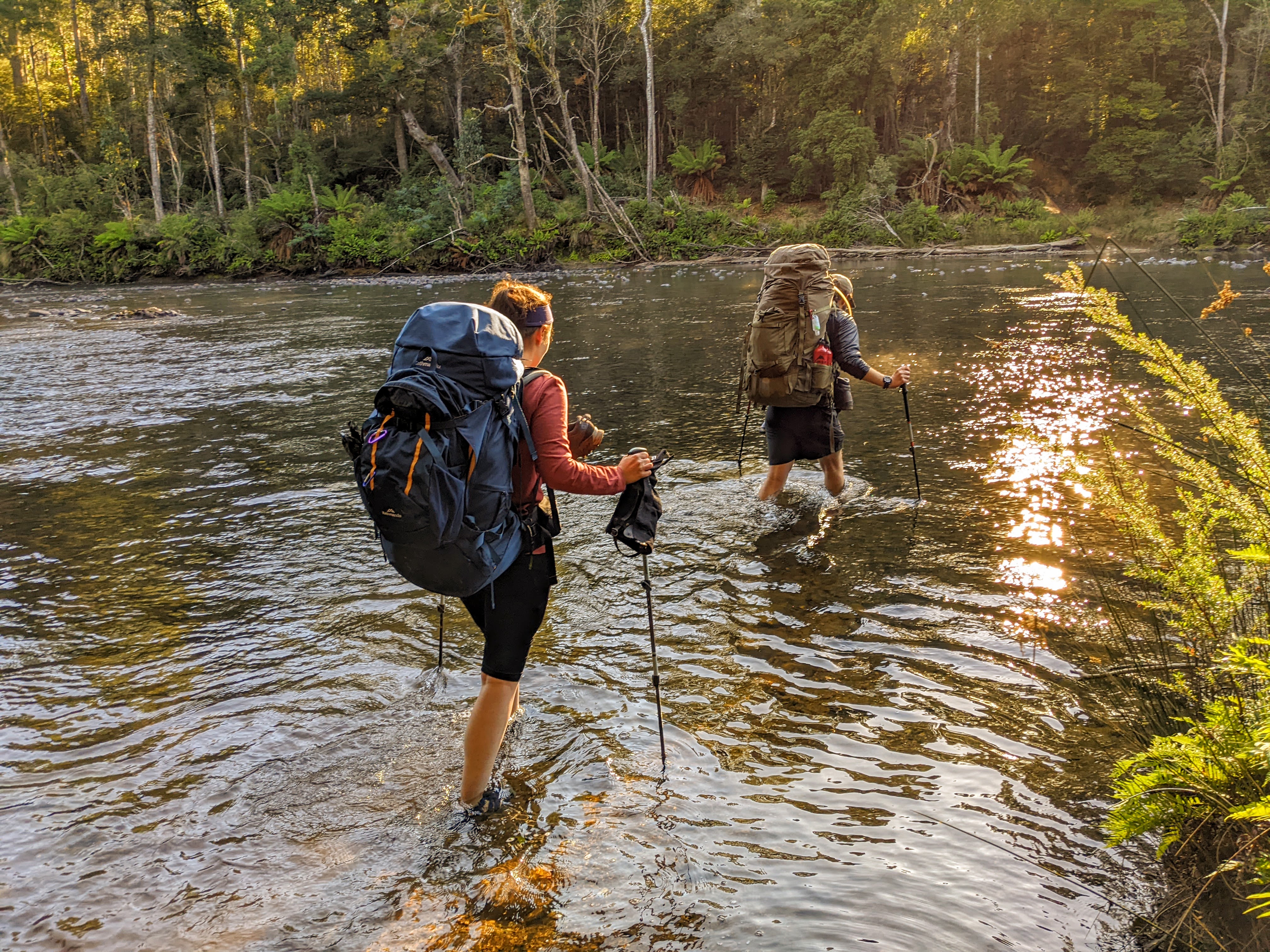
The final river crossing in the early morning light
But it was not only my pack that felt light. My spirit also felt light. The kind of feeling that could only be attained by spending 6 days immersed in nature, isolated from all the things. We reached the end of our hike and sat on the side of a firetrail, enjoying a cup of tea while we waited for our bus to take us back to Launceston. The fluctuations of the mind and heart were perfectly still as I lay on the dirt road, cheeks flushed, looking up at the eucalypts gently swaying against a cloudless blue sky.